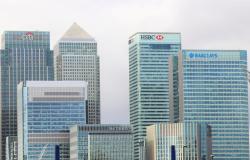Regulation Won’t End Bank Crises. We Must Put Shadow Banks Under Public Control.

Regulations designed by banks to shield their interests will never be enough to halt banking crises, an economist warns.
Recent bank failures in the U.S. have raised the prospect of yet another financial crisis and brought about renewed calls for stricter bank regulations rules. Yet, key questions remain: Why have banking crises become an essential feature of contemporary capitalism? Are strict bank regulations in a capitalist society really the answer to a problem caused by capitalist financial institutions themselves? What should be done to tackle the problem at its root? Internationally renowned Marxist economist Costas Lapavitsas sheds light on these issues in this interview.
Lapavitsas is professor of economics at the School of Oriental and African Studies University of London, and author of numerous books, including Against the Troika: Crisis and Austerity in the Eurozone (with Heiner Flassbeck); The Left Case Against the EU; The Cost of Living Crisis (and how to get out of it) (written with James Meadway and Doud Nicholls); and The State of Capitalism: Economy, Society, and Hegemony (with the EReNSEP Writing Collective).
C.J. Polychroniou: Recent bank failures have revived fears for a repeat of the global financial crisis of the late 2000s. Do we need to look back to the 2007-09 financial meltdown to understand the current banking crisis?
Costas Lapavitsas: The current financial crisis has some common features with that of 2007-09 but is also significantly different. For one thing, it is not nearly as big, though it still has some way to go as I will explain below. More significantly, the turmoil of 2007-09 was a systemic crisis of financialized capitalism, which had expanded aggressively during the previous two decades. What is currently taking place is a crisis of financialized capitalism that is now past its peak.
In the 2010s, financialization continued but without its earlier dynamism. It now relies entirely on the state, while the balance in finance has shifted away from commercial banks and toward shadow banks, i.e., financial institutions that are different from commercial banks because they do not hold deposits used as money. The current crisis has not yet brought into play the shadow banks. We will have a better idea of how serious it is when their condition becomes clearer.
In a little more detail, the crisis of 2007-09 came after an enormous housing bubble spurred by the Federal Reserve drastically lowering the rate of interest in 2001. The speculative mechanisms relied heavily on shadow banks that operated in housing and real estate markets. They securitized mortgage debt by borrowing heavily in the open markets as well as from commercial banks to securitize. Together with commercial banks, they moved aggressively into the subprime mortgage business, securitizing mortgages pushed on poor working people in the inner-city areas of the U.S.
Securitization was profitable primarily because the speculators earned fees and commissions. But the process was extraordinarily risky because mortgages taken by the poorest section of the U.S. working class were mixed with mortgages taken by others to create synthetic financial assets traded as securities in open markets. Great volumes of funds flowed between the U.S. and Western Europe as European banks also took part in the action.
The burst of the bubble that began in 2007 threatened to destroy the entire U.S. banking system. Finance was rescued because the U.S. Treasury made available to it hundreds of billions of tax dollars at the worst moment of the crisis in 2008, while the Federal Reserve supplied banks with enormous volumes of liquidity. Without the support of the state, capitalist accumulation in the U.S. would have ground to a halt, and the world economy would have been thrown into complete disarray. The cost, needless to say, was borne largely by house-owners, mortgage holders, workers and the poor.
But state intervention in 2009 and beyond did not change the structures of financialization. Rather, it protected the key interests benefiting from the growth of finance since the early 1980s. States in the core countries of the world economy adopted austerity throughout the 2010s, worsening the provision of health and education, and exacerbating poverty. At the same time, central banks continued to provide vast quantities of liquidity to the economy in the form of quantitative easing that typically involved creating fiat money.
In the 2010s, the biggest central banks — the Federal Reserve, the European Central Bank, the Bank of Japan, the Bank of England — became truly enormous institutions through quantitative easing. At present, the largest money markets of the world economy, through which private financial institutions and large multinationals obtain liquidity, are practically incapable of operating without extensive central bank support. Through their vast intervention, central banks brought interest rates to extraordinarily low levels throughout the 2010s, an unprecedented development in the history of capitalism.
And yet, despite state intervention, capitalist accumulation at the core of the world economy remained historically feeble. In the 2010s, growth was at its weakest in decades, while average profitability floundered along. Fixed capital investment remained relatively low, and productivity growth was very poor. The engine of capitalist accumulation ran on fumes after 2007-9, and the result was the growth of “zombie firms” across core countries that were able to survive only because interest rates remained low for such a long time.
State intervention, however, allowed finance to recover in the 2010s, even though there was no bubble remotely similar to that of the 2000s. Commercial banks retreated in relative terms and had fewer opportunities for profits as the speculative mechanism of mortgage securitization was broken. The real beneficiaries of the 2010s were shadow banks, particularly the huge investment funds that came to dominate financial markets.
These are portfolio holders — asset speculators — who seek cheap funding to buy stocks and shares in the hope of profiting from price increases, dividends and interest payments. Three of these funds currently control more that 25 percent of the entire equity capital of the U.S. This concentration of property is, again, a development without precedent in the history of capitalism.
In sum, the decade that followed 2007-9 witnessed financialization go past its peak as a historical trend, while accumulation remained weak, profitability failed to rise systematically, and there was no clear alternative direction for the world economy. This highly unstable configuration was shaken hard by COVID-19, which struck the already weakened side of production by forcing closures of firms, sending workers home, and disrupting global production chains.
We saw massive state intervention during the 2007-09 financial meltdown and no less so during the COVID-19 pandemic. Indeed, it seems that the capitalist state will always be around to bail out the financial sector, primarily thanks to the tools employed by the central banks, but it seems that crises never disappear.
Indeed, an even more extraordinary bout of state intervention compared to the preceding decade took place in 2020-21. Central banks created truly phenomenal volumes of liquidity by accelerating the quantitative easing policies practiced since 2007-09. They loaded up on public and private debt and drove interest rates practically to zero. The balance sheet of the Federal Reserve reached $9 trillion, more than a third of U.S. GDP. States also increased fiscal expenditure to support aggregate demand and prevent unemployment from escalating. In 2020, the ratio of public debt to GDP in the U.S. exceeded 130 percent, the same level as in the Second World War.
Gigantic state intervention in 2020-21 prevented catastrophe but it did not resolve the underlying problem: that is, the weakness of accumulation. And so, it gave to the turmoil a new and more complex form that is already appearing as the current banking crisis.
Enormous state borrowing in 2020-21 created conditions for a bubble in public bonds. Both commercial banks and shadow banks took advantage of near-zero interest rates and abundant liquidity to buy government bonds and other financial assets on the assumption that interest rates would remain low and thus bond prices would stay high. Commercial banks also avidly expanded credit in 2020-21 as money became practically free. Private indebtedness grew rapidly.
This preposterous financial jamboree at a time when real accumulation was in deep trouble could not but end up in major trouble. The weakness of supply at a time when demand was strongly supported by the state led to inflation, which accelerated rapidly in 2022, approaching 10 percent in core countries. Big businesses took advantage of rising prices to maintain their profit margins, not least by speculating through further tightening supply. Wages lagged behind, and so workers’ real income declined. What took place in 2022 was a gigantic transfer of income from workers to capitalists through the acceleration of inflation.
Speaking of inflation, doesn’t it actually threaten the foundations of financialized capitalism?
Inflation threatens the very foundations of financialized capitalism. Big businesses can take advantage of it to raise their profits for a period, but the financial interest and lenders in general are threatened since inflation eats into the capital of lenders and disrupts their activities. The ruling elite of contemporary capitalism knows of only two methods to suppress it: first, keep wages down, thus lowering workers’ real income and, second, raise interest rates. In 2022, interest rates escalated rapidly from near zero to more than 4 percent at the core of the world economy.
The trouble was that raising interest rates completely disrupted the speculative business models adopted by financial institutions in 2020-21. It soon became clear that commercial banks — such as Silicon Valley Bank (SVB), which had bought government bonds and other assets using cheap liquidity — were effectively bankrupt. The rise of interest rates, on the one hand, destroyed their profitability by increasing the cost of liquidity and, on the other, created a hole in commercial bank assets by ending the bubble in government bonds and bringing their prices down.
For the moment, intervention by the U.S. government, again committing public credit, has prevented the worst. But it is unlikely that this will be the end of the crisis. The reason is that the speculative drive into bonds permeated the financial system in 2020-21. If interest rates stay at the current high levels to bring inflation down, the possible losses on the holdings of bonds and other financial assets might be in the hundreds of billions of dollars.
Where do these losses lie? The probability is that shadow banks as well as commercial banks are facing huge holes in their balance sheets. If this is true, the crisis has every chance of proving equally severe to 2007-9. We will only know as time goes by and the dirt comes to the surface through further shocks.
Today, just like during the 2007-09 financial meltdown, there are calls for stricter bank regulation rules. This is a rather tiresome refrain, isn’t it?
The fresh crisis and the need for urgent state intervention to rescue finance have led indeed to the usual cries for tougher regulation, stronger capital requirements, harsher stress tests, and the like, to ensure that the banking system in the U.S. and elsewhere becomes “secure.” It cannot be overemphasized how much nonsense such talk is, especially after four decades of repeated banking crises across the world. This type of regulatory intervention does absolutely nothing to prevent crises — SVB would have passed all tests with flying colors shortly before it collapsed. This is regulation largely designed by the banks to protect the interests of the banks, not the public.
The financialization of capitalism has witnessed the sustained growth of a private financial system that penetrates every corner of social activity. Finance periodically engages in frenzies of speculation, only to rely on public support for its rescue. Commercial banks enjoy a privileged position in this respect because they create the money that people use in everyday life. Thus, they are able to make private profits, while socializing their losses. More prudential regulation will do absolutely nothing to improve the situation.
If bank regulations rules do not work, what’s the answer to banking crises which remain a constant feature of financialized capitalism and, potentially, threaten to bring down entire economies?
What should be done is indeed the critical question. Is the answer to let commercial banks fail, as some argue, replacing them with financial institutions that do not create money (essentially shadow banks)? These institutions would, presumably, provide the loans that capitalist firms — and possibly households — require in the form of financial assets to be traded in open markets. Meanwhile, the money that is necessary for economic life would be created directly by the central bank, perhaps by everyone holding an account directly with it. Prime candidates for that are central bank digital currencies, which are currently under consideration across the world.
There is nothing particularly novel about such proposals, it should be said, except for the new and modern-sounding digital currency. The notion that banks should be effectively turned into investment funds was originally proposed by the American economist Irving Fisher in the 1930s as the “Chicago Plan,” and it keeps reappearing in academic and policy circles. There are two fundamental problems with it.
First, commercial banks are extraordinarily flexible in generating the credit that is necessary for capitalist accumulation, while at the same time creating money. If they were replaced by investment funds that could not create money, the credit-generating capability of the financial system would suffer greatly. That would constrain productive accumulation, with everything this implies for workers’ employment, incomes, and so on. Financialization is already characterized by weak accumulation, and hobbling the creation of credit would make things worse.
Second, the notion that the central bank should be the sole provider of money after eliminating money created by private banks calls for the greatest caution. For the central bank to deliver this task properly, it would have to anticipate and preempt the pace of economic activity across the entire economy. In effect, it would have to become a planner on a grand scale. Furthermore, if the money created by the central bank is to be digital and provided on, say, the basis of blockchain technology, that would give to the central bank enormous capabilities to collect information about individual citizens across society. The planner would begin to acquire dictatorial powers. Be careful what you wish for.
Financialized capitalism already possesses enormously powerful central banks that are presumably “independent.” Reform in the interests of working people does not involve further strengthening of central banks. What is needed is wholesale intervention to create public banks that do not operate speculatively but are subject to effective regulation of interest rates and volumes of credit, while being imbued by a spirit of public service. At the same time, the enormously expanded shadow banks should be brought under control, and democratization should take place at the central bank. On this basis, the weakness of the productive sphere should be tackled head on through policies that shift the balance in favor of public property. That is the path to overturning the destructive financialized capitalism of our times.
C.J. Polychroniou is a political scientist/political economist, author, and journalist who has taught and worked in numerous universities and research centers in Europe and the United States. Currently, his main research interests are in U.S. politics and the political economy of the United States, European economic integration, globalization, climate change and environmental economics, and the deconstruction of neoliberalism’s politico-economic project. He is a regular contributor to Truthout as well as a member of Truthout’s Public Intellectual Project. He has published scores of books and over 1,000 articles which have appeared in a variety of journals, magazines, newspapers and popular news websites. Many of his publications have been translated into a multitude of different languages, including Arabic, Chinese, Croatian, Dutch, French, German, Greek, Italian, Japanese, Portuguese, Russian, Spanish and Turkish. His latest books are Optimism Over Despair: Noam Chomsky On Capitalism, Empire, and Social Change (2017); Climate Crisis and the Global Green New Deal: The Political Economy of Saving the Planet (with Noam Chomsky and Robert Pollin as primary authors, 2020); The Precipice: Neoliberalism, the Pandemic, and the Urgent Need for Radical Change (an anthology of interviews with Noam Chomsky, 2021); and Economics and the Left: Interviews with Progressive Economists (2021).
This first appeared on Truthout and was reposted with permission.
Photo by Expect Best


